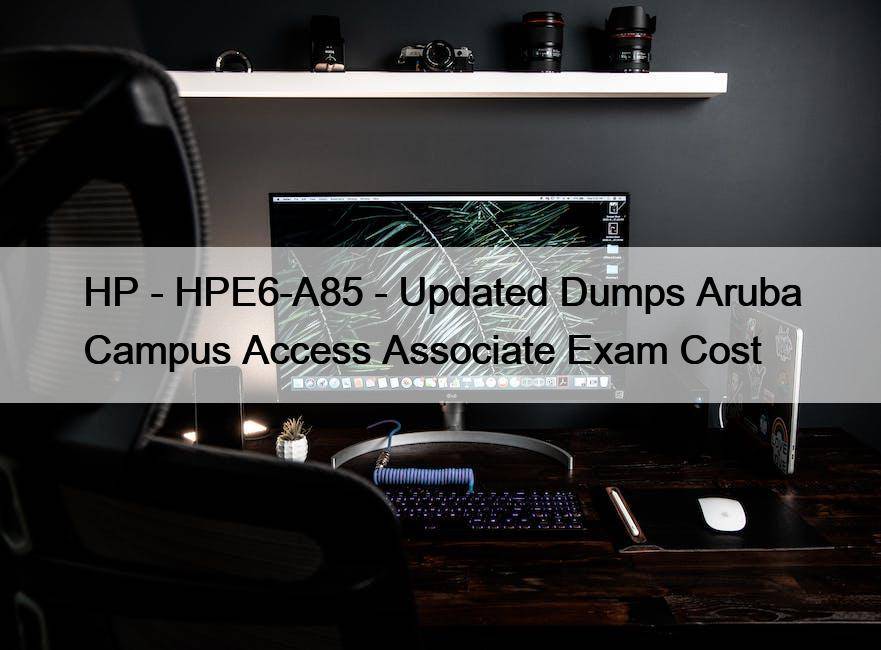Most Popular
 C-THR89-2411 Latest Test Question & C-THR89-2411 Reliable Test Blueprint
C-THR89-2411 Latest Test Question & C-THR89-2411 Reliable Test Blueprint
If you hope to get a job with opportunity of ...
 Microsoft MS-900 Clearer Explanation - MS-900 Reliable Exam Pass4sure
Microsoft MS-900 Clearer Explanation - MS-900 Reliable Exam Pass4sure
What's more, part of that UpdateDumps MS-900 dumps now are ...
 Certified-Business-Analyst Study Materials - Certified-Business-Analyst Valid Exam Bootcamp
Certified-Business-Analyst Study Materials - Certified-Business-Analyst Valid Exam Bootcamp
P.S. Free 2025 Salesforce Certified-Business-Analyst dumps are available on Google ...



HP - HPE6-A85 - Updated Dumps Aruba Campus Access Associate Exam Cost

After clients pay for our HPE6-A85 exam torrent successfully, they will receive the mails sent by our system in 5-10 minutes. Then the client can dick the links and download and then you can use our HPE6-A85 questions torrent to learn. Because time is very important for the people who prepare for the exam, the client can download immediately after paying is the great advantage of our HPE6-A85 Guide Torrent. So it is very convenient for the client to use and study with our HPE6-A85 exam questions.
HP HPE6-A85 Certification Exam is an industry-recognized certification that provides a valuable credential to network professionals. It validates the candidate's knowledge and skills in Aruba Campus Access Solutions and demonstrates their ability to design, implement, and manage enterprise wireless LANs and other mobile solutions. Aruba Campus Access Associate Exam certification exam is an excellent way to enhance your career prospects and open up new opportunities in the field of wireless networking.
Valid HPE6-A85 Exam Vce | Latest HPE6-A85 Test Sample
HPE6-A85 training materials have now provided thousands of online test papers for the majority of test takers to perform simulation exercises, helped tens of thousands of candidates pass the HPE6-A85 exam, and got their own dream industry certificates HPE6-A85 exam questions have an extensive coverage of test subjects and have a large volume of test questions, and an online update program. HPE6-A85 Study Material has a high quality service team. First of all, the authors of study materials are experts in the field. They have been engaged in research on the development of the industry for many years, and have a keen sense of smell for changes in the examination direction.
HP HPE6-A85 Exam is an excellent entry-level certification for networking professionals interested in wireless network technologies. It is globally recognized and validates the essential skills needed to configure and manage medium-sized wireless networks using Aruba products. Aruba Campus Access Associate Exam certification is highly valued in the networking industry and helps individuals advance their careers and increase their marketability.
HP Aruba Campus Access Associate Exam Sample Questions (Q15-Q20):
NEW QUESTION # 15
Which Aruba technology will allow for device-specific passphrases to securely add headless devices to the WLAN?
- A. Wired Equivalent Privacy (WEP)
- B. Opportunistic Wireless Encryption (OWE)
- C. Multiple Pre-Shared Key (MPSK)
- D. Temporal Key Integrity Protocol (TKIP)
Answer: C
Explanation:
Explanation
Multiple Pre-Shared Key (MPSK) is a feature that allows device-specific or group-specific passphrases to securely add headless devices to the WLAN Wireless Local Area Network. WLAN is a wireless computer network that links two or more devices using wireless communication to form a local area network (LAN) within a limited area such as a home, school, computer laboratory, campus, or office building. . MPSK enhances the WPA2 PSK Wi-Fi Protected Access 2 Pre-Shared Key. WPA2 PSK is a method of securing your network using WPA2 with the use of the optional Pre-Shared Key (PSK) authentication, which was designed for home users without an enterprise authentication server. mode by allowing different PSKs for different devices on the same SSID Service Set Identifier. SSID is a case-sensitive, 32 alphanumeric character unique identifier attached to the header of packets sent over a wireless local-area network (WLAN). The SSID acts as a password when a mobile device tries to connect to the basic service set (BSS) - a component of the IEEE
802.11 WLAN architecture. . MPSK passwords can be generated or user-created and are managed by ClearPass Policy Manager12. References:
https://blogs.arubanetworks.com/solutions/simplify-iot-authentication-with-multiple-pre-shared-keys/ 2
https://www.arubanetworks.com/techdocs/ClearPass/6.8/Guest/Content/AdministrationTasks1/Configuring-MPS
NEW QUESTION # 16
Where are wireless client roaming decisions made?
- A. Virtual Controller
- B. Joint decision made by the origination and destination APs
- C. Aruba Central
- D. Client device
Answer: D
Explanation:
Explanation
Wireless client roaming decisions are made by the client device based on its own criteria, such as signal strength, noise level, data rate, etc. The network can influence the client's roaming decision by providing information such as neighbor reports, load balancing, band steering, etc., but the final decision is up to the client.
References:https://www.arubanetworks.com/techdocs/Instant_86_WebHelp/Content/instant-ug/wlan-roaming/cli
NEW QUESTION # 17
Which commands are used to set a default route to 10.4.5.1 on an Aruba CX switch when ln-band management using an SVl is being used?
- A. ip route 0.0 0 0/0 10.4.5.1
- B. ip route 0 0 0.070 10.4 5.1 vrf mgmt
- C. iP default-gateway 10.4.5.1
- D. default-gateway 10.4.5.1
Answer: A
Explanation:
The command that is used to set a default route to 10.4.5.1 on an Aruba CX switch when in-band management using an SVI is being used is ip route 0.0 0 0/0 10.4.5.1 . This command specifies the destination network address (0.0 0 0) and prefix length (/0) and the next-hop address (10.4.5.1) for reaching any network that is not directly connected to the switch. The default route applies to the default VRF Virtual Routing and Forwarding. VRF is a technology that allows multiple instances of a routing table to co-exist within the same router at the same time. VRFs are typically used to segment network traffic for security, privacy, or administrative purposes. , which is used for in-band management traffic that goes through an SVI Switch Virtual Interface. SVI is a virtual interface on a switch that allows the switch to route packets between different VLANs on the same switch or different switches that are connected by a trunk link. An SVI is associated with a VLAN and has an IP address and subnet mask assigned to it12. Reference: 1 https://www.arubanetworks.com/techdocs/AOS-CX/10_08/HTML/ip_route_4100i-6000-6100-6200/Content/Chp_StatRoute/def-rou.htm 2 https://www.arubanetworks.com/techdocs/AOS-CX/10_08/HTML/ip_route_4100i-6000-6100-6200/Content/Chp_VRF/vrf-overview.htm
NEW QUESTION # 18
A customer has just implemented user and device certificates via a company-wide Group Based Policy (GPO).
Which EAP method requires client certificates when authenticating to the network?
- A. PEAP
- B. EAP-TTLS
- C. EAP-TLS
- D. EAP-TEAP
Answer: C
Explanation:
EAP-TLS is an authentication method that requires client certificates when authenticating to the network.
It provides mutual authentication between the client and the server using public key cryptography and digital certificates.
References:
https://www.arubanetworks.com/techdocs/ClearPass/6.9/Guest/Content/CPPM_UserGuide/EAP-TL
NEW QUESTION # 19
Which flew in a Layer 3 IPv4 packet header is used to mitigate Layer 3 route loops?
- A. Time To Live
- B. Checksum
- C. Protocol
- D. Destination IP
Answer: A
Explanation:
The field in a Layer 3 IPv4 packet header that is used to mitigate Layer 3 route loops is Time To Live (TTL). TTL is an 8-bit field that indicates the maximum number of hops that a packet can traverse before being discarded. TTL is set by the source device and decremented by one by each router that forwards the packet. If TTL reaches zero, the packet is dropped and an ICMP Internet Control Message Protocol (ICMP) Internet Control Message Protocol (ICMP) is a network protocol that provides error reporting and diagnostic functions for IP networks. ICMP is used to send messages such as echo requests and replies (ping), destination unreachable, time exceeded, parameter problem, source quench, redirect, etc. ICMP messages are encapsulated in IP datagrams and have a specific format that contains fields such as type, code, checksum, identifier, sequence number, data, etc. ICMP messages can be verified by using commands such as ping , traceroute , debug ip icmp , etc . message is sent back to the source device. TTL is used to mitigate Layer 3 route loops because it prevents packets from circulating indefinitely in a looped network topology. TTL also helps to conserve network resources and avoid congestion caused by looped packets.
The other options are not fields in a Layer 3 IPv4 packet header because:
Checksum: Checksum is a 16-bit field that is used to verify the integrity of the IP header. Checksum is calculated by the source device and verified by the destination device based on the values of all fields in the IP header. Checksum does not mitigate Layer 3 route loops because it does not limit the number of hops that a packet can traverse.
Protocol: Protocol is an 8-bit field that indicates the type of payload carried by the IP datagram. Protocol identifies the upper-layer protocol that uses IP for data transmission, such as TCP Transmission Control Protocol (TCP) Transmission Control Protocol (TCP) is a connection-oriented transport layer protocol that provides reliable, ordered, and error-checked delivery of data between applications on different devices . TCP uses a three-way handshake to establish a connection between two endpoints , and uses sequence numbers , acknowledgments , and windowing to ensure data delivery and flow control . TCP also uses mechanisms such as retransmission , congestion avoidance , and fast recovery to handle packet loss and congestion . TCP segments data into smaller units called segments , which are encapsulated in IP datagrams and have a specific format that contains fields such as source port , destination port , sequence number , acknowledgment number , header length , flags , window size , checksum , urgent pointer , options , data , etc . TCP segments can be verified by using commands such as telnet , ftp , ssh , debug ip tcp transactions , etc . , UDP User Datagram Protocol (UDP) User Datagram Protocol (UDP) is a connectionless transport layer protocol that provides
NEW QUESTION # 20
......
Valid HPE6-A85 Exam Vce: https://www.certkingdompdf.com/HPE6-A85-latest-certkingdom-dumps.html
- HPE6-A85 Latest Test Labs 🙇 HPE6-A85 Latest Test Pdf 🕘 Dumps HPE6-A85 Vce 🥮 Open ▶ www.examdiscuss.com ◀ enter ➽ HPE6-A85 🢪 and obtain a free download 💫New HPE6-A85 Test Forum
- HPE6-A85 Detail Explanation 📩 HPE6-A85 Reliable Test Vce 🦞 Latest HPE6-A85 Test Question 🕗 Search on [ www.pdfvce.com ] for 《 HPE6-A85 》 to obtain exam materials for free download 🥿Reliable HPE6-A85 Test Materials
- HPE6-A85 Detail Explanation 🤙 HPE6-A85 Exams Collection 🎻 HPE6-A85 Exam Simulations 🏃 Search on ▛ www.pass4leader.com ▟ for { HPE6-A85 } to obtain exam materials for free download 🔂HPE6-A85 Detail Explanation
- Valid HPE6-A85 Exam Review 🥞 HPE6-A85 100% Correct Answers 🤸 Reliable HPE6-A85 Test Materials 🙌 Open 【 www.pdfvce.com 】 enter 《 HPE6-A85 》 and obtain a free download 😑Valid HPE6-A85 Exam Review
- HPE6-A85 Reliable Test Vce 🛂 New HPE6-A85 Test Forum 🤙 HPE6-A85 Exam Simulations 🏟 Search for { HPE6-A85 } and download it for free on 《 www.prep4pass.com 》 website 🟦HPE6-A85 Detail Explanation
- Reliable HPE6-A85 Test Materials 📌 Valid HPE6-A85 Exam Review 🏺 HPE6-A85 Valid Test Online 🧄 Copy URL ➠ www.pdfvce.com 🠰 open and search for ➤ HPE6-A85 ⮘ to download for free 📶New HPE6-A85 Test Forum
- Latest HPE6-A85 Exam Experience 🕔 Valid HPE6-A85 Exam Review 😀 HPE6-A85 Exams Collection 🚹 Search for ➽ HPE6-A85 🢪 and easily obtain a free download on “ www.getvalidtest.com ” 🤛Learning HPE6-A85 Mode
- Exam HPE6-A85 Reviews ☑ HPE6-A85 Exam Revision Plan 📉 HPE6-A85 Exam Revision Plan 🦊 Download 《 HPE6-A85 》 for free by simply entering ▷ www.pdfvce.com ◁ website 🎿HPE6-A85 Exam Simulations
- www.testsdumps.com HP HPE6-A85 Dumps PDF 🥏 Search for ➥ HPE6-A85 🡄 and easily obtain a free download on 「 www.testsdumps.com 」 👽HPE6-A85 100% Correct Answers
- HPE6-A85 latest dumps 🌯 Search for ➤ HPE6-A85 ⮘ and easily obtain a free download on [ www.pdfvce.com ] 🦩HPE6-A85 Latest Test Pdf
- Valid HPE6-A85 Exam Review 🙆 HPE6-A85 Detail Explanation 📉 HPE6-A85 Exam Revision Plan 🔨 Simply search for ▷ HPE6-A85 ◁ for free download on ( www.pass4test.com ) 📀Dumps HPE6-A85 Vce
- HPE6-A85 Exam Questions
- www.9kuan9.com www.56878.asia 15000n-11.duckart.pro www.x64z.com 5000n-03.duckart.pro www.zybls.com 淦威天堂.官網.com 武森天堂.官網.com 47.121.119.212 havin84241.newbigblog.com
Tags: Dumps HPE6-A85 Cost, Valid HPE6-A85 Exam Vce, Latest HPE6-A85 Test Sample, HPE6-A85 Exam Study Solutions, New HPE6-A85 Exam Book